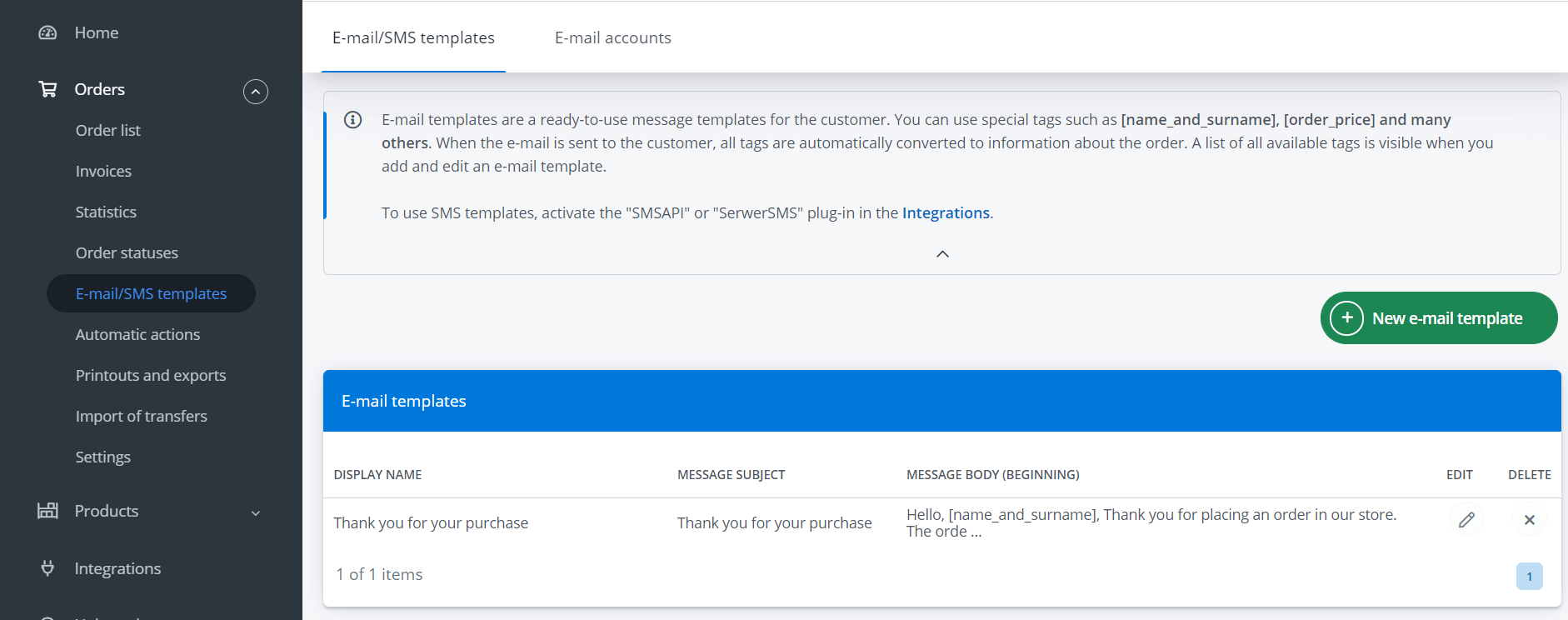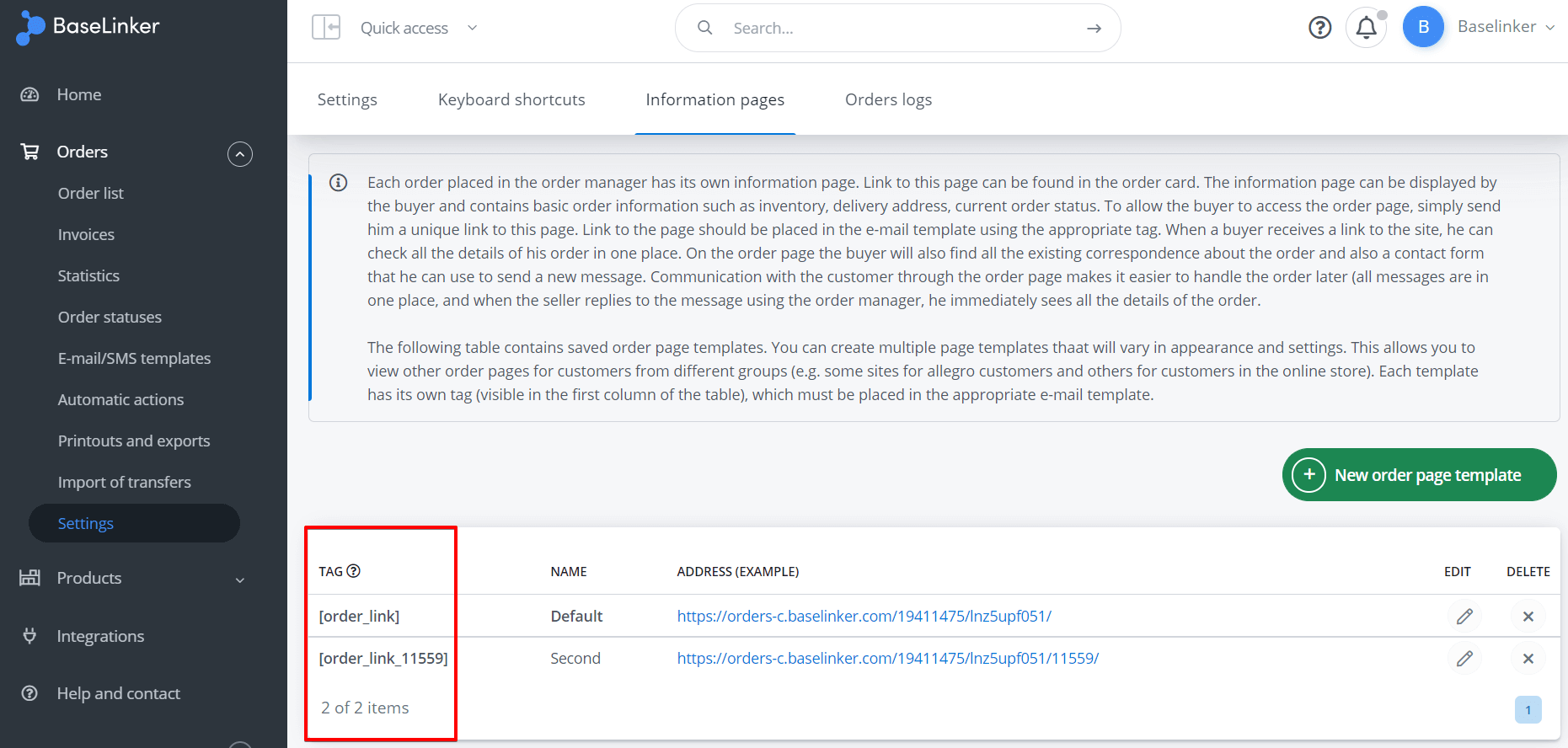Sending SMS messages requires activation of a separate plugin in Integrations.
When the system is properly configured, messages can be sent automatically when the selected event occurs, for example:
- when the delivery option form and payment confirmation has been received for a given Allegro order, the system sends a Thank you for shopping e-mail template to the customer containing a list of ordered products and a link to the order information page;
- after issuing the invoice and sending the package, the system sends an e-mail template Your order has been sent to the customer containing the attached invoice, a photo image of the packed parcel and a shipment tracking link.
Creating templates
E-mail and SMS are ready-made message templates. You can use them both to send automatic messages and send them manually from the order card or order list. On the order list the templates will be visible under the envelope icon and on the order card – at the bottom of the page. You can also assign email templates to your own mailboxes.
You can add your own e-mail templates in the Orders → E-mail/SMS templates. There are no restrictions regarding the number of created templates.

Each template is composed of the following elements:
- Display name – name that will be displayed in the system and will identify a given template. This name will not be displayed to the customer;
- Message subject – you can use the special tags discussed in the Tags in messages section;
- Format – you can create the message content as plain text or HTML code. If you use HTML tags when creating a template, remember to choose the HTML format – otherwise the tags will appear in the message;

- Message content – when creating content you can use special tags discussed in the Tags in messages section;
- E-mail account – address from which the message will be sent;
- Template hidden on the list option – check Yes if this e-mail template will only be used when defining automatic actions. It will not be visible in the list of e-mails elsewhere in the system (except for creating automatic actions);
- Attachments – discussed in section Message attachments;
- Template language – in accordance with the selected language, certain elements of the message will be translated e.g. some tags.
E-mail templates can use HTML tags to format text. A template can contain up to 25,000 characters, with CSS files linked from an external address.
You must assign a selected e-mail address for sending to each template.
When creating e-mail templates, use our special tags, which are automatically converted into order-related information the moment the message is sent.
You can place Base tags in both the content and title of the message. You can add your email templates as plain text as well as HTML code (remember to choose the appropriate option in the Format field – Plain text or HTML code).
Sample e-mail to thank for the purchase:
Hello [name],
Thank you for ordering from our store.
The ordered products:
[items_list]
All the information related to your order, including the progress of your order, can be checked on your personal order page:
[order_link]
Message generated automatically, please do not reply. Preferred contact through the form available on the order page.
Best regards
The current list of tags is visible in the Seller’s Panel, in Orders → E-mail/SMS Templates section, in template edition mode. After hovering the cursor over the selected tag, the system will display the description. Just click on the tag to insert into the template.
The table below discusses the most frequently used tags.
| Tag |
Additional information |
| [invoice_link] |
-
- If you want to include a invoice link, in your email, use the [invoice_link] tag. If you want it to be an invoice link rediction, place a link in this form: <a href=”[invoice_link]”>Link to the invoice. Alternatively, you can also send the invoice in the form of a attachment to the message.
.
- Dependent on the plug-in settings, this link may show an invoice from connected online accounting system (e.g. IFakturownia, Firmao, IFirma, inFakt, wFirma etc.)
- If a pro forma invoice is issued instead of a standard invoice, link will refer to a pro forma invoice
|
| [client login] |
- If the buyer is unregistered, then the e-mail with this tag can, for example, appear as “Welcome unregistered”. In order to avoid this, it is worth to set a separate automatic action with a different email template when the buyer is unregistered.
|
| [shipment_track_link]
[shipment_track_link_en]
|
- The availability of this tag depends on the carrier. The tracking link is available in the form provided by the carrier (or broker).
- For several selected carriers it is also possible to refer to the website in English
|
| [order_price] |
- The automatic action sending an e-mail with the tag [order_price] must be created upon the The delivery option form has been downloaded event, instead of “Order Downloaded”. Allegro orders are created in the BaseLinker system by adding products to them successively. If the message sending action is set to be performed when the order is downloaded to the first status, the message is sent immediately for a yet incomplete order. In this case, the message sent to the customer will only show the price of the first product without the price of subsequent products and without the shipment value.
|
| [items_list]
[items_list2] |
- The automatic action sending an e-mail with the tag [items_list] must be created upon the The delivery option form has been downloaded event, instead of “Order Downloaded”. Allegro orders are created in the BaseLinker system by successively adding other products. If the message sending action is set to be performed when the order is downloaded to the first status, the message is sent immediately for a yet incomplete order. In such a case, only the first of several purchased products will appear in the message sent to the customer.
|
| [order_link] |
- If you want to put link to the default order information page in the message content, use the tag [order_link].
|
| [order_aa_last_error] |
- This tag will return the error message that occurred as the last one during the attempt to perform automatic actions for the order. You can use this tag, for example, in a message for orders that are in the To Be Shipped status for a certain number of days.
|
Additional, user-created order page templates also have their own tags. They are visible in the first column of the table in section Orders → Settings → Information pages.

The e-mail content is displayed as programmed in the template. The message on the order page is displayed without HTML tags.
Message attachments
You can include up to three attachments to each email template. Each attachment can come in one of three available forms:
- Select a file from the disk – you can add any file from disk and set a specific name, for example return card, complaint card, etc.;
- Attach invoice/document, file or selected printout – any document, file from an additional field, or printout from created system printouts and exports;
- Package photo (PickPack Assistant) – the Base PickPack Assistant allows the user to take a photo of the completed order. More information on this can be found in the article Packing Assistant module.
If a pro forma invoice is issued for an order instead of a standard invoice, a pro forma invoice will be added as an attachment.
In addition, depending on the plugin settings, an invoice from the connected online accounting system can be attached. More information about this can be found in the article Online accounting systems integrations.
Manual message sending
Sending messages from the order card
An e-mail or SMS can be sent manually from the order card. For this purpose, it is worth using one of the previously prepared templates.

There are several types of messages sent in the system:
- Message on the order page + e-mail (with content);
- Message on the order page + e-mail (without content) – the message will be displayed on the order page and an email notification about the appearance of such a message will be sent (not containing its content);
- Only the message on the order page;
- Only e-mail message;
- Only for seller (hidden message) – the message will not be sent to the customer. The content of the message will be displayed in orange on the order card as an internal message. This method is often used by users with multiple employees. The Exchange of messages table can serve as a window for exchanging information about the order between employees.
Regardless of the selected option, all messages will be visible on the order card.
Sending messages from the order list
You can also send e-mail or SMS messages in bulk from the order list. After selecting the desired orders, select the Send message button.

Sending messages with automatic actions
Base can automatically send e-mails or SMS messages after a specific event has occurred. To do so, in Orders → Automatic actions → +Add automatic action section assign the Send e-mail or Send SMS action to the selected event.

Here you have to choose:
- e-mail template;
- mailbox;
- message address (here you can choose both the customer’s e-mail address in the order and define any fixed e-mail address, for example to confirm that the message has been sent or to forward the information to the selected corporate department);
- message type, discussed in section above.
In the settings of each template or automatic action, you can choose which e-mail account should be used to send messages. If other addresses are provided in the template and in the action, the client will receive a message sent from the e-mail address indicated in the automatic action, regardless of what address is assigned in the message template.
Please remember a few rules when designing automatic actions:
- e-mail to the customer can be sent, among other things, when the status of a given order changes in Base. However, the change of statuses in the shop through an integration file or API will not trigger such an action. Therefore, it is not possible to create an automatic action based on the online store status change, unless the changes are made manually from the store’s panel;
- you should pay attention to the construction of automatic actions sending e-mails with attachment. For example, if the system has not yet issued an invoice for a given order, and the event triggering the automatic action sending e-mail to the customer has already occurred, it will be sent without an attached invoice. To avoid such a situation, it is worth to build the automatic action on the basis of the Issued invoice/Issued pro forma invoice event or add the condition Invoice status: Issued;
- for a message to be sent to a valid customer e-mail address, the first automatic action should be carried out upon the The delivery option form has been downloaded event instead of the Order fetched event. Before downloading a delivery option form, the system will display the e-mail address default to the customer’s Allegro account.





